Do you know plants have their own secret language – and the art of companion planting is the ultimate conversation starter? Companion planting strategies have been practiced for centuries, offering a harmonious way to maximize crop growth and ward off pests.
Among the myriad of vegetables that benefit from strategic companionship, beans stand out as a versatile and rewarding addition to any garden.
Whether you’re cultivating bush beans, pole beans, or even unique varieties like runner beans or lima beans, choosing the right companions can significantly enhance your bean crop’s health and yield.
In this article, we will explore the top 13 options for companion planting with beans, unveiling a world of possibilities to help you create a thriving and sustainable garden ecosystem.
From aromatic herbs to vibrant flowers and other complementary vegetables, discover the perfect partners that will not only boost your bean harvest but also enrich your overall gardening experience.
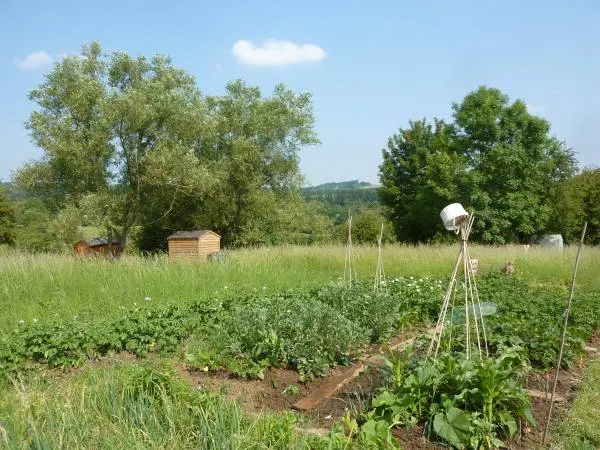
What are Companion Plants?
Companion plants are a group of plants that are grown together in close proximity because they provide mutual benefits to each other.
This gardening strategy involves strategically planting certain species alongside one another to enhance growth, improve pest control, increase pollination, and maximize overall garden productivity.
Reasons to Choose Companion Plants
There are several compelling reasons to choose companion plants in your garden. They can provide natural pest control by repelling or confusing harmful insect pests, reducing the need for pesticides. While on the other hand, they can also attract beneficial insects.
Some companion plants enhance soil fertility by tapping into deep nutrients, while others attract pollinators, increasing yields. Additionally, companion planting offers complementary growth benefits, like shading sun-sensitive crops or providing physical support.
Aromatic herbs and flowers mask vegetable scents, making it harder for pests to locate their target plants. They also attract beneficial insects that prey on garden pests and contribute to a healthier ecosystem.
Lastly, incorporating crop rotation with companion plants disrupts pest and disease cycles, promoting overall garden health.
Beans as Companion Plants
Bean Plants – A Brief Overview
Bean plants, scientifically classified under the Phaseolus genus within the Fabaceae family, represent a vital agricultural and nutritional resource. These annuals exhibit diverse growth habits, ranging from compact bush beans to climbing pole beans.
Sporting compound leaves with three leaflets; bean plants produce striking, often white, pink, or purple flowers that are crucial for their reproduction.
These self-pollinating flowers ultimately give rise to pods, which vary in size, shape, and color according to the bean variety. Within these pods, bean seeds develop, brimming with protein, carbohydrates, and other essential nutrients that make them a valuable food source.
Cultivated in a wide range of climates and soil types, beans also play a pivotal role in soil fertility through nitrogen fixation, benefiting crop rotation practices.
Advantages of Beans as Companion Plants:
Nitrogen Fixation:
Bean plants, particularly legumes like green beans, pole beans, etc. have the unique ability to fix atmospheric nitrogen into a form that other plants can use, enriching the soil with this essential nutrient. This benefits nitrogen-loving plants like corn, cucumbers, and brassicas.
Trellising Support:
Pole bean varieties provide natural trellising support for vining plants such as cucumbers, tomatoes, and squash, maximizing space and sunlight utilization.
Shade and Windbreak:
The lush foliage of bean plants offers shade for sun-sensitive crops like lettuce and spinach and acts as a windbreak, protecting smaller plants from strong gusts.
Prevent Soil Erosion:
Bush beans protect the soil from erosion by groundcovering.
Disadvantages of Beans as Companion Plants:
Excess Nitrogen:
While beans’ nitrogen-fixing ability is beneficial for many crops, it can be a disadvantage when used excessively. In some cases, an overabundance of nitrogen from beans can lead to imbalanced soil conditions and affect the growth of certain plants that prefer lower nitrogen levels.
Attract Mexican Bean Beetles:
Beans, especially certain varieties like green beans, can attract Mexican bean beetles, which are known to feed on bean plants.
The Mexican bean beetle (Epilachna varivestis) is a small, destructive insect pest. These beetles are native to Mexico and the southern United States but can be found in various regions of North America.
Mexican bean beetles are often mistaken for ladybugs due to their similar appearance, but they are typically copper-colored and have a distinctive pattern of 16 black spots on their wing covers. These beetles are known for their voracious appetite and their ability to defoliate bean plants rapidly, which can lead to reduced crop yields and, in severe infestations, plant death.
So, it requires additional pest management efforts in the garden.
Top 13 Companion Plants for Beans
1- Squash , Corn – And the “THREE SISTER TECHNIQUE”

Squash and corn are two plants that are indeed considered the best companion plants for beans, and they are often used together in a gardening technique known as the “Three Sisters.” This ancient agricultural method, attributed to Native American tribes such as the Iroquois, maximizes the benefits of planting these three crops together. Here’s how the Three Sisters technique works:
Corn (Maize): Corn serves as the first sister in this trio. Corn stalks provide a natural trellis for the bean vines to climb. The sturdy cornstalks offer support for the pole beans vines as “poles”, allowing them to grow vertically and access more sunlight. This allows to make room for more plants in the garden. In return, beans fix nitrogen in the soil, benefiting the nitrogen-hungry corn plants. This mutual support promotes healthier growth for both crops.
Beans (Legumes): Beans are the second sister in the Three Sisters trio. They are nitrogen-fixing plants, which means they have a symbiotic relationship with nitrogen-fixing bacteria in their root nodules. These bacteria take atmospheric nitrogen and convert it into a form that can be used by plants, enriching the soil with this essential nutrient. Beans also act as a living mulch, shading the soil and reducing weed growth, which benefits both corn and squash.
Squash (Cucurbita): Squash is the third sister and plays a crucial role in this companion planting technique. Summer squash plants have large, leafy canopies that help shade the soil beneath, reducing evaporation and retaining moisture. This shading effect helps keep the soil cooler and prevents weed growth. Additionally, the prickly squash vines and leaves act as a natural deterrent to certain pests, helping protect the corn and beans.
2- Catnip
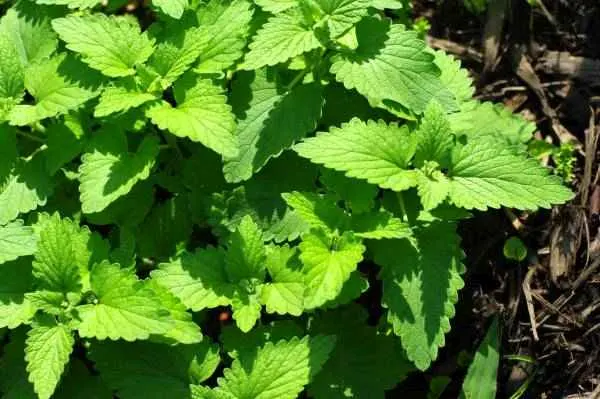
Catnip (Nepeta cataria) can be a valuable companion plant for beans in your garden, albeit with a more indirect role than traditional companions like corn and squash.
Catnip attracts beneficial insects such as bees and butterflies, which can significantly enhance bean pollination and, subsequently, yield. Furthermore, catnip’s strong aroma acts as a natural pest deterrent, keeping common garden nuisances like aphids, flea beetles, and ants at bay.
By strategically planting catnip along the edges or borders of your bean rows or beds, you can create a protective shield against these pests while allowing your bean plants to thrive.
3- Basil
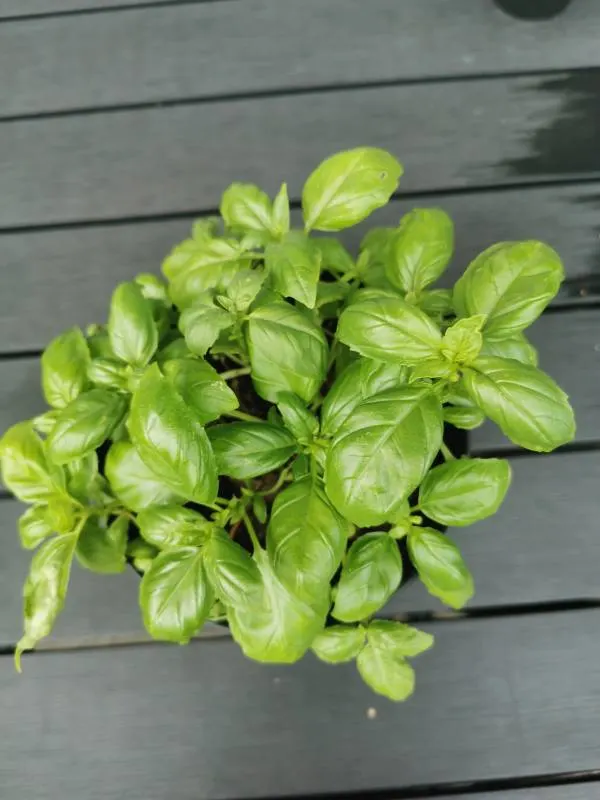
Basil (Ocimum basilicum) serves as an excellent companion plants for beans in your garden, offering multiple benefits to these legumes.
Growing beans in proximity to basil, the nitrogen-fixing bacteria associated with the beans release nitrogen into the soil. Nearby basil plants can then take up this available nitrogen, which promotes their growth and leaf production.
This increased nitrogen availability can lead to lusher and more prolific basil plants, with more leaves that can be harvested for culinary use.
Moreover, basil’s strong aroma repels bean pests like aphids, whiteflies, and spider mites, acting as a natural defence when planted with beans. This reduces the need for pesticides and promotes a healthier vegetable garden.
4- Marigold
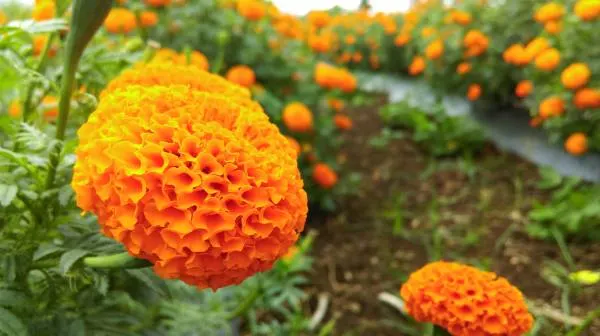
Marigold (Tagetes spp.) is indeed known for their ability to repel Mexican bean beetles (Epilachna varivestis), making them the best companion plants for beans. Marigolds contain compounds like pyrethrum and limonene in their scent, which deter many common garden pests.
The strong scent of plant marigolds, particularly French marigolds (Tagetes patula), acts as a natural repellent against these destructive pests. Mexican bean beetles can defoliate bean plants and significantly reduce yields, so using marigolds as a protective barrier around your bean plants can help minimize beetle infestations.
These companion plant for beans also improves the soil’s health by producing chemicals that suppress the growth of harmful soil-borne nematodes. This quality is particularly advantageous for beans, as they can be susceptible to nematode damage.
5- Radish
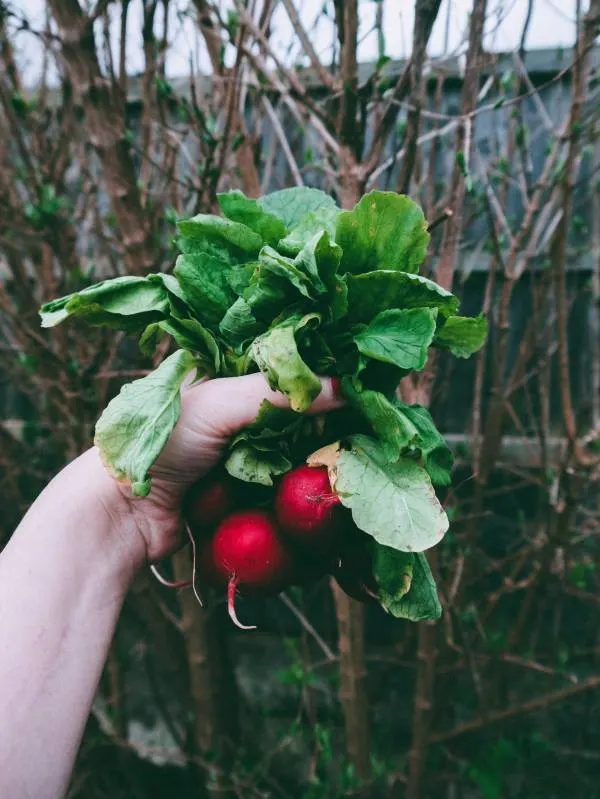
When talking about ideal companion plants, radish is also one of the best companion plants for beans, offering several advantages through their unique characteristics.
Planting beans with radish can be beneficial as radish acts as a natural weed suppressor for young bean plants, shading the soil with their leaves and preventing weed growth. This reduces competition for resources and can contribute to growing bean plants healthier. It also acts as a trap crop that repel flea beetles.
Furthermore, these companion plants for beans have a rapid growth cycle, typically maturing in just a few weeks. This quick growth can help improve the soil structure by breaking up compacted soil and increasing aeration. This, in turn, benefits bean plants by providing them with better access to oxygen, nutrients, and water.
On the other hand, pole beans and bush beans provide partial shade to the radish as they love to grow in a cool environment.
6- Cucumber
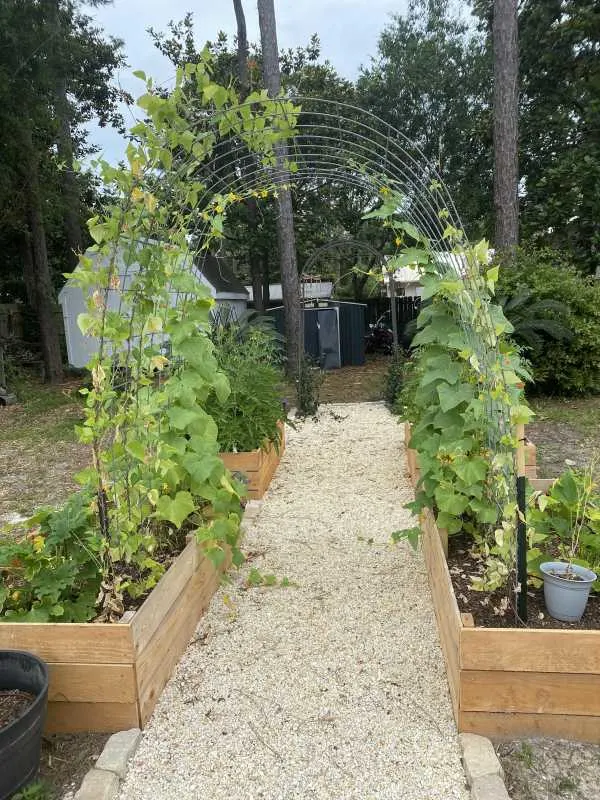
Cucumber plants benefit bean plants in several ways. Bush beans and cucumbers share similar growing requirements, making them ideal companion planting.
Cucumber vines spread along the ground, offering natural ground cover that keeps the soil cool and adequately moist, conditions that are beneficial for beans as well.
Pole beans, known for their climbing nature, can make use of cucumber trellises for support, maximizing sunlight exposure and airflow, which contributes to their robust growth. Meanwhile, the nitrogen-enriched soil created by the beans, with their nitrogen-fixing ability, offers essential nutrients for cucumber plants, further bolstering their health and productivity.
For successful companion planting, consider planting cucumbers and beans in the same bed or interspersing them within rows. Additionally, trellising cucumbers can maximize space and sunlight for both crops, as cucumber vines tend to grow vertically when provided with support.
This symbiotic relationship between cucumbers and beans can lead to healthier, more productive plants and a more efficient use of garden space.
8- Nasturtium
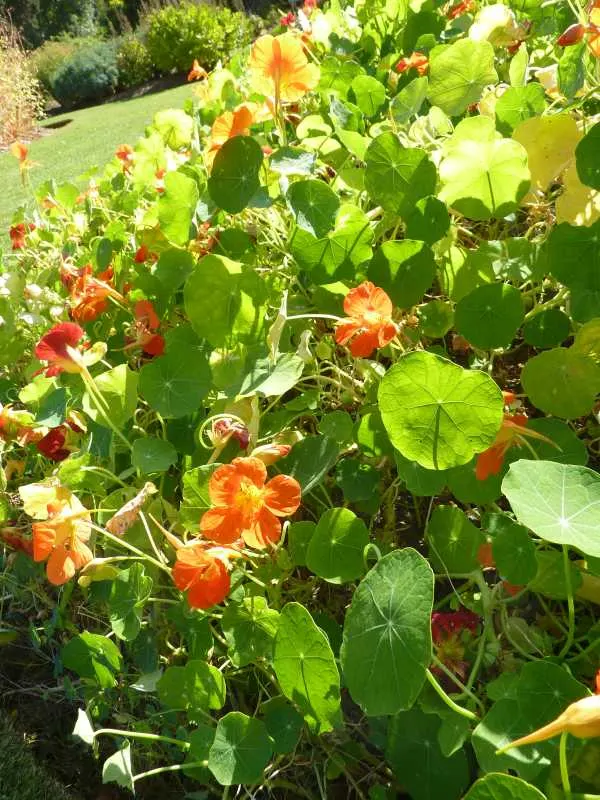
Nasturtium (Tropaeolum majus) is on of the excellent companion plants for beans. Its vibrant, edible flowers and distinctive foliage not only add aesthetic appeal to the garden but also offer several benefits.
Nasturtiums act as a natural pest repellent that helps repel Mexican bean beetles, aphids, whiteflies, flea beetles and other common bean pests. Planting them alongside beans can help protect the bean crop from infestations.
Additionally, nasturtiums can attract beneficial insects like ladybugs, which feed on aphids and other harmful pests, further contributing to pest control in your garden. Also, it acts as a living mulch around bean plants.
This companion planting strategy enhances the health and vitality of your bean plants while adding a burst of color to your garden landscape.
9- Potato
Potato plants as companion plant for beans offers a dynamic partnership in the garden. Potato foliage serves as living mulch, providing shade and moisture retention for beans, conditions that promote their growth. Also, nitrogen boost beans help potato plants for optimal growth.
Moreover, this pairing offers additional advantages as bean plant help deter the colorado potato beetles, a common pest of potato plants, while potatoes, in turn, repels Mexican bean beetles, a notorious adversary of beans.
This mutually protective relationship repels bean beetles and other pest infestations and enhances the overall health and productivity of both crops, making them a harmonious and resource-efficient garden combination.
10- Rosemary
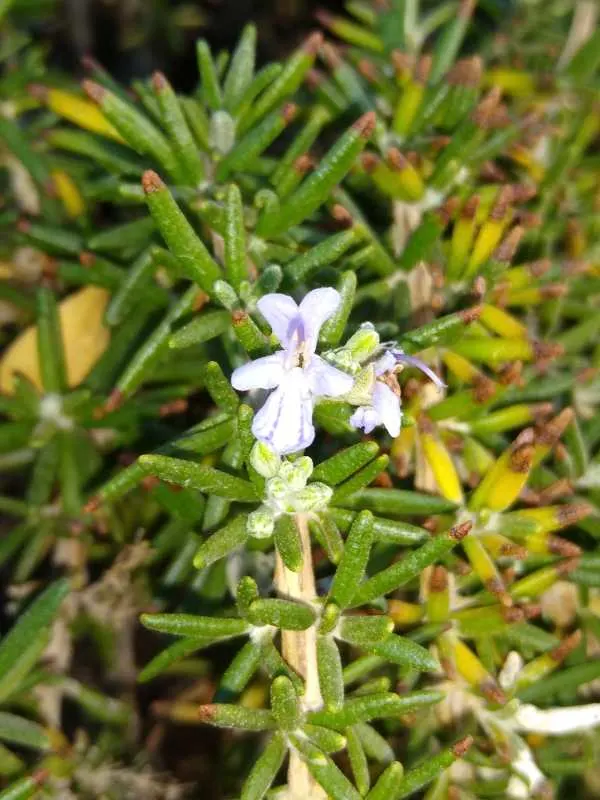
Another plant that deter mexican bean beetles is rosemary and that’s why this companiopn planting is on our list of the best companion plants for beans.
Rosemary, with its aromatic nature, has the capability to deter bean beetles while the herb benefits from nitrogen boost beans. This nitrogen help rosemary with increased foliage.
11- Summer Savory
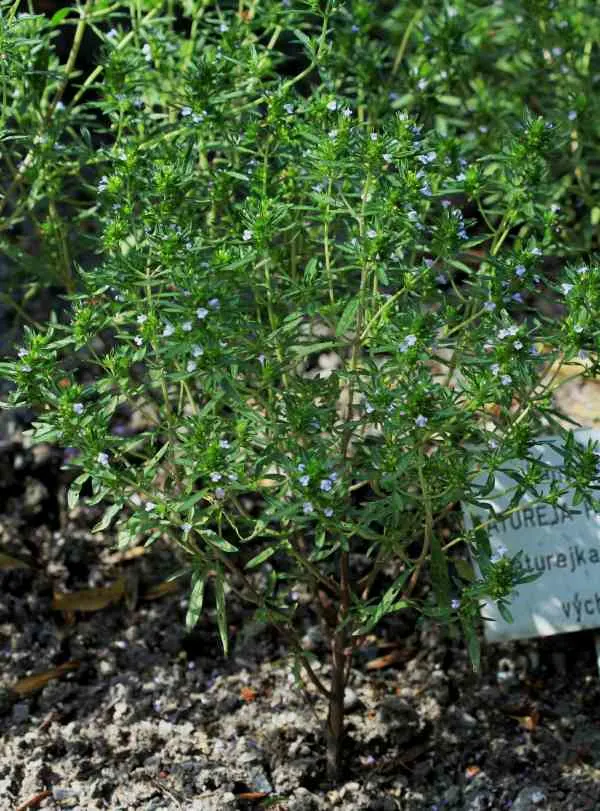
Summer savory is known as one of the best beans companion planting for two main things- flavour enhancemnt and deter Mexican bean beetles. In return, summer savory benefit from the nitrogen boost from the beans. These plant can grow tall up to 18 inches and that why they won’t crowd young bean plants.
What Companion Plants For Beans to Avoid?
1- Onion & Garlic
Vegetable crops like onion, garlic, leeks and scallions, belonging to allium family are not a good option when opting best companion plants for beans in a vegetable garden.
The primary reason to avoid these pairing is that the members of this family release a compounds into the soil that kill the beneficial bacteria in the bean roots. This causes bean plants to prevent infusing nitrogen to the soil.
2- Beets
Beets affect the two bean plant varieties – bush beans and pole bean plants, differently.
Growing pole beans varieties with companion plants as beet, the two plants affect each other adversely by stunting one another’s growth. While bush beans aren’t affected by beets at all.
3- Peppers
Pepper plants aren’tbest companion plants for beans in a vegetable garden. Both beans and peppers have qualities that enhance soil quality. But the pole bean vines can be a problem sometimes.
They can grow overly aggressive, sprawling among neighboring plants, including peppers. The vigorous growth of pole bean vines can overshadow and choke out pepper plants, limiting their access to sunlight and potentially tangling or weighing down their stems.
Conclusion
Beans, a staple in many gardens, have several potential companions that can boost their growth, health, and yield.
I hope you’ve got variety of options as best companion plants for beans while also some plants varieties that does not make a good pairing for companion planting with beans.
Every garden is unique, and while guidelines are helpful, it’s always good to observe and learn from your own green space. Happy gardening!
